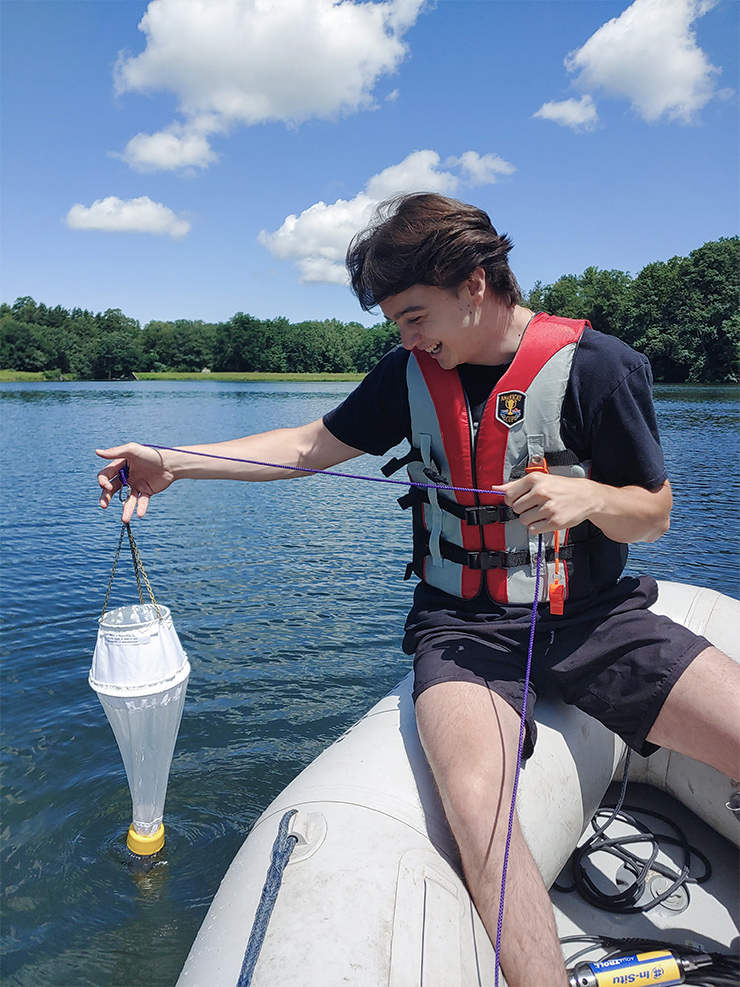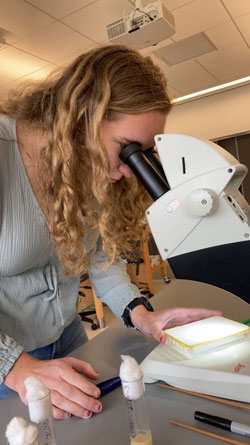

Harrison Youngers prepares plates to grow C. elegans worms as part of ongoing research being conducted this summer with Dr. Jonathan Kniss.


Harrison Youngers prepares plates to grow C. elegans worms as part of ongoing research being conducted this summer with Dr. Jonathan Kniss.
It’s summer, but learning doesn’t go on hiatus for SUNY Fredonia science students undertaking summer research projects, both on campus and out in the field.
The work will strengthen their academic credentials ahead of applying to graduate and professional schools or pursuing direct employment opportunities.
For all students, becoming engaged in authentic research improves their understanding of the process of science and the skills and knowledge they develop are especially attractive to potential employers and to the admissions committees of graduate and professional schools” - Dr. William Brown
Ten students – a number that’s rebounded to pre-pandemic levels – are immersed in experiential learning under the mentorship of Department of Biology faculty, thanks to scholarships that are generously supported by endowments through the Fredonia College Foundation. Students earn $3,500 for the 10-week research experiences and receive a $1,000 research budget.
“The greatest benefits are the skills and knowledge gained from being intimately involved in the process of scientific discovery,” said Department of Biology Chair William Brown. “These are marketable skills in a variety of careers in science and technology.”
“By gaining this opportunity to focus on research in an immersive way, our students become better scientists, with better critical thinking and communication skills, and they become more attractive in the market for jobs and graduate programs,” Dr. Brown added.
The depth of connection to future educational goals and career expectations differs among students. For many, the experience allows them to discover whether a research career is the right path for them. “For all students, becoming engaged in authentic research improves their understanding of the process of science and the skills and knowledge they develop are especially attractive to potential employers and to the admissions committees of graduate and professional schools,” Brown added.
Summer research projects are about students meaningfully contributing to, and often driving forward, significant research projects, said Visiting Assistant Professor Jonathan Kniss. In fact, the department’s greatest research output occurs during the summer.
Quite often, there’s a continuation or expansion of experiments initiated during the academic year that has a goal of acquiring the data needed to complete a particular aspect of a project. However, an intern Dr. Kniss is mentoring this summer is piloting a brand-new project which they started from scratch.
“The expectation is that whatever progress we make during the internship period will be continued during the academic year by the same student and other undergraduate researchers in my lab,” Kniss, a developmental biologist, added.
What stands out the most, Brown noted, is the diversity of the projects, which represents the diversity of research interests within the biology department.
Participating students, accompanied by their approaching year of study, major, hometown, research project and mentor, include:
• Sophia Olson, junior, Molecular Genetics, Warren, PA – “Generation of Supernumerary Centrosomes via Estrogen-linked Signaling,” Associate Professor Nicholas Quintyne;
• Quinn Halstead, senior, Molecular Genetics, Fulton, NY – “The Contribution of CENP-O Complex to PIk1 Recruitment and Retention at the Kinetochore and its Effect on Mitotic Defects,” Dr. Quintyne;
• Gavin Monaghan, senior, Molecular Genetics, Rochester, NY – “Effect of NuMA Gene Knockdown on the Frequency of Mitosis Mitotic Defects, and Aberrant Centrosome Number in OSCC103 Cancer Cells,” Quintyne;
• Harrison Youngers, junior, Molecular Genetics, East Aurora, NY – “Behavioral and Genetic Effects of BPA Exposure on Dopaminergic Neurons in Caenorhabditis elegans,” Kniss;
• Marc Guilliod, junior, Adolescence Education: Biology, Floral Park, NY – “Spatial Distribution of Mantid Egg Clutches in Chautauqua County,” Brown;
• William Damiani, junior, Biochemistry, Hamburg, NY – “Reconstructing the Fredonia Reservoir's Past to Understand its Future,” Associate Professor Courtney Wigdahl-Perry;
• Jamison Horch, senior, Exercise Science, Fredonia, NY – “An Investigation of Rotator Cuff Strength in both Baseball and Softball Athletes using the ActivForce 2 Dynamometer,” Associate Professor Todd Backes;
• Colleen Tytler, senior, Biology, minor in Communication, Silver Creek, NY – “Analysis of Antidiabetic and Antihypertensive Effects of Creatine in vivo,” Dr. Backes;
• Rachel Echevarria, senior, Environmental Sciences, minors in Biology and Psychology, Fredonia, NY – “Bat Behavioral Response to Avian Predators & Expansion of Acoustic Surveying for Bat Activity and Species Richness in WNY,” Associate Professor Karry Kazial;
• Dakota Richter, junior, Biology, minor in Communication, Silver Creek, NY – “Assessment of Bat Activity and Species Diversity Using Acoustic Surveys in WNY,” Dr. Kazial.
Endowments supporting the projects include The Holmberg Foundation/Dr. Robert Wettingfeld Science Endowment, Constantine Barker Memorial Fund, Yunghans-Dietter Research Award and the Joseph and Jane (Schuster) Falcone Endowment for Scholarship and Research, all through the Fredonia College Foundation. The Biology Endowment Fund also supports this research.
Highlights of some of these research projects include the following:
Developing a profile of the village of Fredonia’s reservoir to help predict future trends that it may experience is the focus of research by William Damiani. He learned of real-world applications that research has while shadowing Dr. Wigdahl-Perry’s aquatic lab – where his summer experience is based – during the Fall 2023 semester.

The main feature Mr. Damiani has already experienced is connecting with new people.
“I truly love this part because I believe it to be the most important aspect of science, how people with similar goals can come together to work towards something innovative and worthwhile,” he explained.
Damiani, who’d like to pursue a master’s degree in Biochemistry, is interested in a career as an anesthesiologist or virologist.
Gaining hands-on experience in a lab and in the field, as well as giving back to the community, attracted Dakota Richter to a research opportunity with Associate Professor Karry Kazial that assesses bat activity and species diversity primarily in Chautauqua County through the use of acoustic surveys.
“I'm focusing on acoustic surveying with a focus on a particular endangered species which was spotted in the area I am looking at. This knowledge is crucial for understanding the biodiversity and ecological health of the area being surveyed,” Mr. Richter explained.
The Northern Long-Eared Myotis was discovered at the College Lodge in the summer of 2022 during research conducted by Isabella Surma, then an undergraduate student who earned a B.S. in Biology. Later in 2022, the U.S. Fish and Wildlife Service reclassified this bat from threatened to the more ominous endangered status, meaning that a species is in danger of extinction throughout all or a significant portion of its range, Richter said.
“With this species being endangered it's important to conduct a new survey to see if it's still in the area so that collaborative conservation efforts can be made,” Richter commented.
“Not a lot of people understand the impact bats have on our society,” he noted. As insectivores, they eat flying insects, such as mosquitoes, that are otherwise considered nuisances to humans. Bats have contributed to yearly savings of over $3 billion in pesticide application costs in the United States alone, according to Richter.
It’s Richter’s hope that his surveys will generate interest among residents in the kinds of bats in the area. Also planned is survey work along Eighteen Mile Creek to provide an updated study in neighboring Erie County. “This knowledge is crucial for understanding the biodiversity and ecological health of the area being surveyed,” Richter added.
After graduation, Richter plans to enroll in either a physician assistant school or registered nurse or nurse practitioner program. He’s worked as a certified nursing assistant since last March, accruing 2,000 healthcare hours while maintaining his studies.
Colleen Tytler is conducting research in the Women’s Health and Exercise Lab in the Department of Kinesiology at Penn State University. She’s very passionate about physiology, reproductive endocrinology, metabolism research and providing outreach and support to those struggling with the Female and Male Athlete Triad and deepening her knowledge of exercise physiology and related areas.

The triad is characterized as a condition where an individual experiences a continuum of three main health outcomes: energy deficiency, reproductive suppression and impaired bone health. It’s primarily brought upon by energy deficiency, as an imbalance exists between energy intake and energy expenditure associated with exercise, Ms. Tytler explained.
Chronic energy deficiency can lead to menstrual disturbances in women and decreased sperm/androgen production in men, and increased bone loss can lead to a higher occurrence of bone stress injuries, such as stress fractures.
With the support of Backes, her research mentor, Tytler landed a position in the lab of Dr. Mary Jane De Souza, who has pioneered Triad-related research at Penn State. Tytler joined the Female and Male Athletic Triad Coalition, an international coalition of individuals who hold positions in a range of medical, investigative, academic and athletic areas who, through research, education and advocacy, aim to promote the health and well-being of exercising individuals.
Tytler is passionate about exploring the biochemical aspects of metabolism, endocrinology, physiology and pharmacology in graduate school as she goes on to obtain a Ph.D. in one of these fields. “I would love to conduct research on metabolic disease and continue to explore reproductive endocrinology as it relates to the Triad so that I can help and advocate for those who struggle with these outcomes,” she said.
Since BPA is found in a wide range of consumer products, Harrison Youngers found a research experience that investigates the behavioral and genetic effects of BPA exposure on dopaminergic neurons in C. elegans to be intriguing.
BPA (Bisphenol-A) is used to make plastics and resins and is commonly found in products such as the inside coating of some food cans, paper receipts, plastic cutlery and dental sealants, Mr. Youngers said. Also found in water bottles and other beverage containers, it’s so widespread that 90 percent of Americans have traceable amounts of BPA in their urine, according to the study, Calafat et al., 2005, he cited.
It's classified as an endocrine disrupting compound (EDG), which means it can interfere with the body’s hormones, Youngers explained.
Exposure to BPA has been linked to reproductive disorders, heart disease and developmental problems in children, but there’s still ongoing research to better understand the full effects of BPA on humans.
“Our study on C. elegans aims to further contribute to understanding BPA’s potential impacts,” Youngers said.
The project is enabling Youngers to gain hands-on experience in research, which will enhance his resume, while also allowing him to build stronger connections with professors and staff.
“I am currently exploring careers in scientific research and medicine. I am particularly interested in becoming a medical doctor.”
Gavin Monaghan welcomed the opportunity work to in a lab without time restrictions that come into play with a full class schedule, thus simulating a full-time research position. He’s also excited to continue learning from his current faculty mentor.
Learning several research techniques that will benefit him in future research opportunities will be a key takeaway from the project. Monaghan also stands to strengthen his credentials, thus improving his chances of being accepted into the graduate school of his choice.